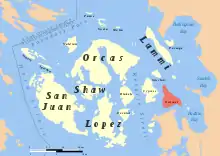Guemes Island
Guemes Island is a small island in western Skagit County, Washington, United States. It is located north of Fidalgo Island and the city of Anacortes, and is accessible by private boat and by the Guemes Island ferry operated by Skagit County.

Guemes Island was named after the Viceroy of New Spain, Juan Vicente de Güemes, who commissioned an expedition that revealed the islands to Spain in 1794.[1]
Island life
Guemes Island has a rural character with limited facilities.
Some of the island’s beaches are public but most beaches' access is private. There are also two parks: one in the middle of the island known as Schoolhouse Park,[2] and another, Young's Park,[3] located on North Beach near The Guemes Island Resort.
The community located on Guemes Island is generally referred to as "Guemes".
History
Guemes Island is within the historical territory of the Samish Nation. It was a traditional location for Samish winter villages. The Samish language name for the island is Qweng qwengila, which means "many dogs", referring to Salish Wool Dogs, also called Samish Woolley Dogs.[4] Around 1873, the Samish, displaced from their original village by U.S. government policy that made land available to newcomers, established a new village on Guemes near Potlatch Beach. Because they occupied the only natural spring on the island, the Samish were forced off the island by their neighbors in 1912.[5]
Guemes Island was named by the Spanish explorer José María Narváez as Isla de Güemes during the 1791 expedition of Francisco de Eliza, in honor of the Viceroy of Mexico, Juan Vicente de Güemes Padilla Horcasitas y Aguayo, 2nd Count of Revillagigedo.[6][7]
In 1841 Charles Wilkes of the United States Exploring Expedition gave the name "Lawrence Island" to Guemes Island, to honor the American naval officer James Lawrence. He also gave the name "Hornet Harbor" to Guemes Channel, for the USS Hornet, which Lawrence commanded during the War of 1812. To the waterway north of the island, part of Bellingham Bay, Wilkes gave the name "Penguin Harbor", for the British vessel Penguin, captured by Lawrence. These names disappeared after 1847, when the British Captain Henry Kellett reorganized the British Admiralty charts, in the process removing the "pro-American" names given by Wilkes and affirming pro-British names and Spanish names.[8]
Guemes Island was also commonly known locally as Dog Island in the early 20th century, from the large number of Salish Wool Dogs living wild on the island.[9]
Demographics
The following Census statistics represent a block group that also contains the neighboring islands of Cypress Island, Sinclair Island, and Vendovi Island. As of the census[10] of 2000, there were 605 people, 292 households, and 180 families residing in the block group. There were 626 housing units. The racial makeup of the block group was 95.70% White, 1.16% African American, 0.83% Native American, 0.00% Asian, 0.00% Pacific Islander, 0.99% from other races, and 1.32% from two or more races. 1.32% of the population were Hispanic or Latino of any race.
There were 292 households, out of which 22.9% had children under the age of 18 living with them, 57.2% were married couples living together, 3.4% had a female householder with no husband present, and 29.0% were non-families. 30.8% of all households were made up of individuals, and 39.4% had someone living alone who was 65 years of age or older. The average household size was 1.95 and the average family size was 2.38.
In the block group, the population was spread out, with 16.0% under the age of 18, 2.6% from 18 to 24, 11.6% from 25 to 44, 41.3% from 45 to 64, and 27.9% who were 65 years of age or older. The median age was 53 years. For every 100 females, there were 119.2 males. For every 100 females age 18 and over, there were 104.8 males.
The median income for a household in the block group was $40,039, and the median income for a family was unavailable. Income by sex was also unavailable, as was per capita income. 8.1% of the population was below the poverty line. Family poverty statistics were unavailable. Out of the total population, 36.1% of those under the age of 18 and 0.0% of those 65 and older were living below the poverty line.
Magnetic disturbance
Nautical and aeronautical charts note a magnetic disturbance off the southeastern tip of Guemes Island. The disturbance affects compasses enough to cause as much as 2° discrepancy from average local variation.[11]
References
- GuemasIslandLife.org
- "Schoolhouse Park".
- "Young's Park".
- "Coast Salish Placenames of the San Juan Islands and Strait of Georgia". Samish Indian Nation. Retrieved 24 September 2020.
- Ruby, Robert H.; Brown, John A.; Collins, Cary (2013). A Guide to the Indian Tribes of the Pacific Northwest. University of Oklahoma Press. p. 257.
- Phillips, James W. (1971). Washington State Place Names. University of Washington Press. ISBN 0-295-95158-3.
- McDowell, Jim (1998). José Narváez: The Forgotten Explorer. Spokane, Washington: The Arthur H. Clark Company. p. 55. ISBN 0-87062-265-X.
- Meany, Edmond S. (1919). "Origin of Washington Geographic Names". The Pacific Northwest Quarterly. Washington University State Historical Society. X: 56. Retrieved 2009-06-11.
- "Dog-fur knitting: New craft, old Northwest tradition | KPLU News for Seattle and the Northwest". Archived from the original on 2013-01-16. Retrieved 2012-12-04.
- "U.S. Census website". United States Census Bureau. Retrieved 2008-01-31.
- "US Coast Pilot 10, Chapter 7, ¶395" (PDF). Retrieved 2022-11-28.
